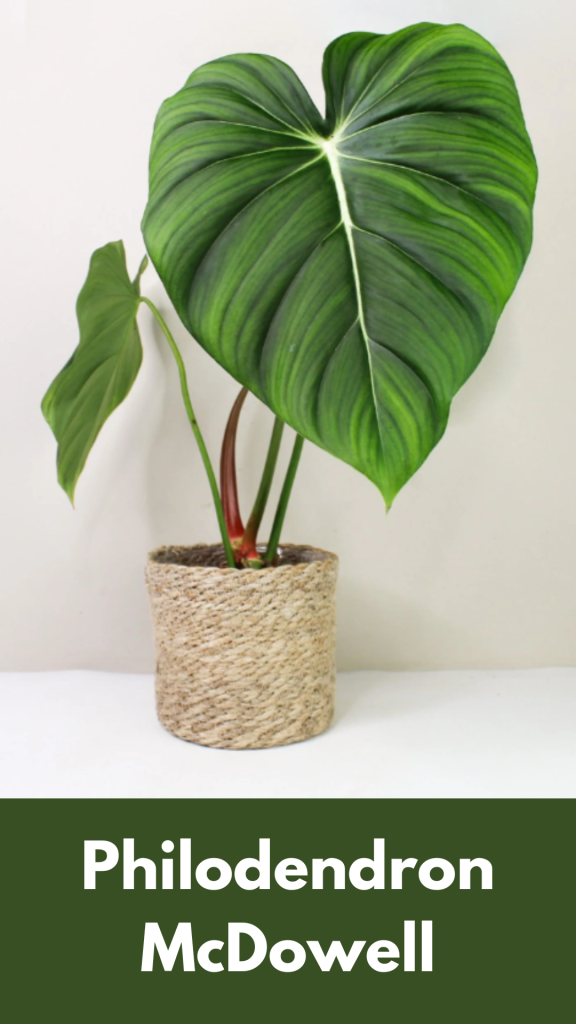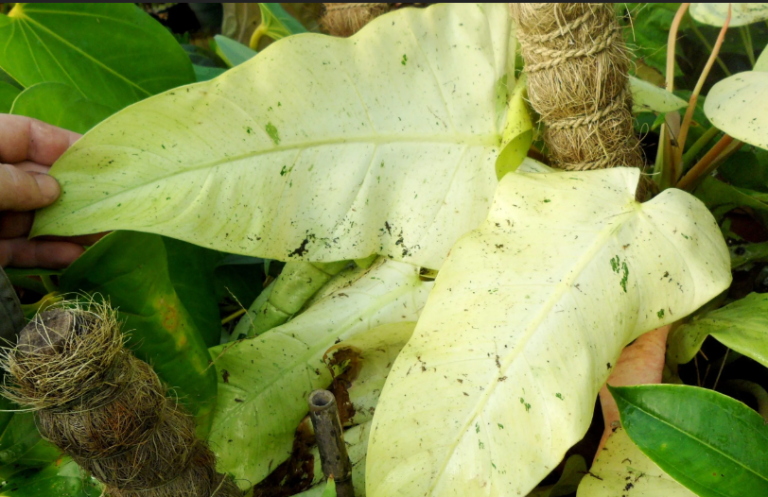Philodendron McDowell is a striking plant with vibrant green foliage and unique leaves that can add a touch of natural beauty to any indoor space. This plant is part of the Philodendron genus, which includes over 500 species of tropical plants native to the Americas. Philodendron McDowell is a popular cultivar that is highly sought after by plant enthusiasts for its attractive appearance and ease of care.

The leaves of Philodendron McDowell are a distinctive feature that sets it apart from other plants in the genus. They have a unique, almost saw-like edge with deep, sharp lobes that give them a striking appearance. The leaves are a glossy green and have a leathery texture, adding to their visual appeal. Philodendron McDowell can grow to be quite large, making it a statement piece in any room or garden.
Philodendron McDowell is also an easy plant to care for, making it an excellent choice for beginners or those who want a low-maintenance plant. It prefers bright, indirect light and well-draining soil. It can tolerate some drought and is generally forgiving if the soil is not consistently moist. With proper care, Philodendron McDowell can thrive for years, adding natural beauty to any space.
Botanical Classification of Philodendron McDowell
| Kingdom | Plantae |
| Clade | Tracheophytes |
| Clade | Angiosperms |
| Clade | Monocots |
| Order | Alismatales |
| Family | Araceae |
| Subfamily | Aroideae |
| Genus | Philodendron |
| Species | Philodendron McDowell |
Benefits of Philodendron McDowell
Philodendron McDowell is more than just a pretty plant – it has a lot of benefits that can make your life better. One of the best things about this plant is that it’s easy to take care of, so even if you don’t have a green thumb, you can still enjoy its beauty. In addition, Philodendron McDowell can help improve the air quality in your home, reduce stress, and make your indoor space more comfortable by increasing humidity levels. Plus, it just looks really nice and can add some natural beauty to any room or garden.
Having plants around is also known to promote relaxation and create a calming atmosphere, which can be especially helpful in today’s fast-paced world. And with its unique leaves and glossy green foliage, Philodendron McDowell can make a statement in any space. Whether you’re a beginner or an experienced gardener, this plant is a great choice for anyone looking to add some natural beauty and health benefits to their life.
How to care for Philodendron McDowell
| Characteristic | Details |
|---|---|
| Temperature | Can tolerate a wide range of temperatures between 60-85°F (15-29°C), but prefers temperatures between 70-75°F (21-24°C) |
| Light | Thrives in bright, indirect light, but can tolerate low light conditions |
| Water | Requires well-draining soil and prefers to be kept evenly moist, but can tolerate some drought |
| Humidity | Prefers moderate to high humidity levels, but can tolerate lower humidity levels |
| Fertilizer | Benefits from regular fertilization during the growing season with a balanced, water-soluble fertilizer |
| Growth rate | Moderate to fast-growing plant |
| Propagation | Can be propagated easily through stem cuttings or division |
| Pests and diseases | Generally pest and disease-resistant, but can be susceptible to spider mites, mealybugs, and root rot if overwatered |
| Lifespan | Can live for several years with proper care |
Note: These characteristics may vary depending on the growing conditions and environment in which the plant is kept.
Propagation guide for Philodendron McDowell
Philodendron McDowell can be propagated through stem cuttings or division. Here is a step-by-step propagation guide for Philodendron McDowell:
Propagation by Stem Cuttings:
- Choose a healthy stem on the parent plant that has at least one or two leaves and is at least 4-6 inches long.
- Use a clean and sharp pair of pruning shears or scissors to make a clean cut just below a node, which is where a leaf attaches to the stem.
- Remove any lower leaves from the cutting, leaving only one or two leaves at the top.
- Dip the cut end of the stem into rooting hormone powder to promote rooting.
- Plant the cutting in a well-draining soil mix, such as a mix of perlite and peat moss.
- Water the cutting thoroughly and place it in a warm, bright, and humid location, but out of direct sunlight.
- Keep the soil moist and mist the cutting regularly to maintain high humidity levels.
- After a few weeks, new growth should appear from the top of the cutting, indicating that it has successfully rooted. At this point, you can move it to a slightly larger pot with regular potting soil.
Propagation by Division:
- Remove the parent plant from its pot and carefully separate the root ball into two or more sections, making sure each section has a healthy root system and some stems and leaves.
- Plant each divided section in its own pot with fresh potting soil.
- Water the newly divided plants thoroughly and place them in a warm, bright, and humid location, but out of direct sunlight.
- Keep the soil moist and mist the plants regularly to maintain high humidity levels.
- After a few weeks, new growth should appear, indicating that the plants have successfully rooted and are growing well.
By following these simple steps, you can easily propagate Philodendron McDowell and enjoy the beauty of this plant in multiple locations.
Commonly Asked Questions About Philodendron McDowell
Q. Is Philodendron McDowell toxic to pets?
Yes, like many plants in the Philodendron family, Philodendron McDowell is toxic to pets if ingested. Keep it out of reach of pets and small children.
Q. How often should I fertilize my Philodendron McDowell?
Philodendron McDowell benefits from regular fertilization during the growing season, which is typically from spring to fall. Use a balanced, water-soluble fertilizer and follow the package instructions for frequency and amount.
Q. Can Philodendron McDowell be grown outdoors?
Philodendron McDowell is primarily an indoor plant and is best suited for growing in a container. However, it can be grown outdoors in warm and humid climates, such as in USDA hardiness zones 10-11.
Q. How often should I water my Philodendron McDowell?
Philodendron McDowell prefers to be kept evenly moist but can tolerate some drought. Water it when the top inch of soil feels dry to the touch, and make sure the soil is well-draining to prevent waterlogged roots.
Q. Can Philodendron McDowell grow in low light conditions?
While Philodendron McDowell prefers bright, indirect light, it can tolerate low light conditions, although its growth may be slower and it may become leggy if the light is too low.
Q. How often should I repot my Philodendron McDowell?
Philodendron McDowell prefers to be slightly root-bound and only needs to be repotted every 2-3 years, or when it has outgrown its current pot.


